The Intel 6th Gen Skylake Review: Core i7-6700K and i5-6600K Tested
by Ian Cutress on August 5, 2015 8:00 AM ESTGenerational Tests on the i7-6700K: Windows Professional Performance
Agisoft Photoscan – 2D to 3D Image Manipulation: link
Agisoft Photoscan creates 3D models from 2D images, a process which is very computationally expensive. The algorithm is split into four distinct phases, and different phases of the model reconstruction require either fast memory, fast IPC, more cores, or even OpenCL compute devices to hand. Agisoft supplied us with a special version of the software to script the process, where we take 50 images of a stately home and convert it into a medium quality model. This benchmark typically takes around 15-20 minutes on a high end PC on the CPU alone, with GPUs reducing the time.
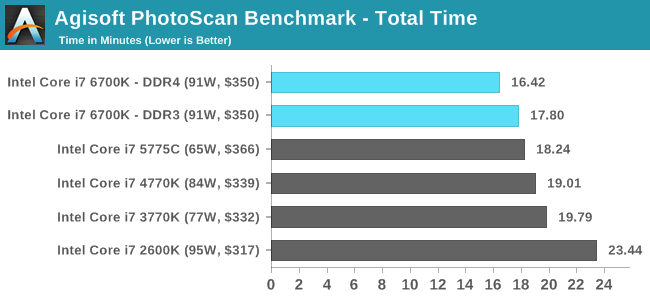
Cinebench R15
Cinebench is a benchmark based around Cinema 4D, and is fairly well known among enthusiasts for stressing the CPU for a provided workload. Results are given as a score, where higher is better.
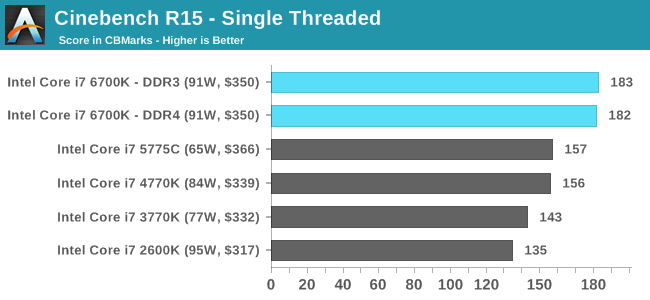
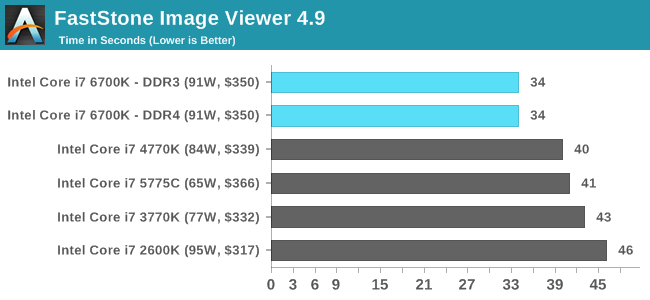
HandBrake v0.9.9: link
For HandBrake, we take two videos (a 2h20 640x266 DVD rip and a 10min double UHD 3840x4320 animation short) and convert them to x264 format in an MP4 container. Results are given in terms of the frames per second processed, and HandBrake uses as many threads as possible.
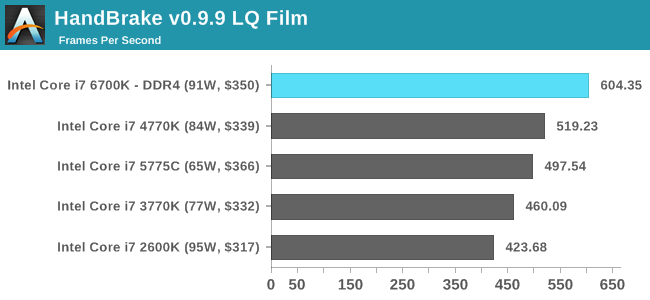
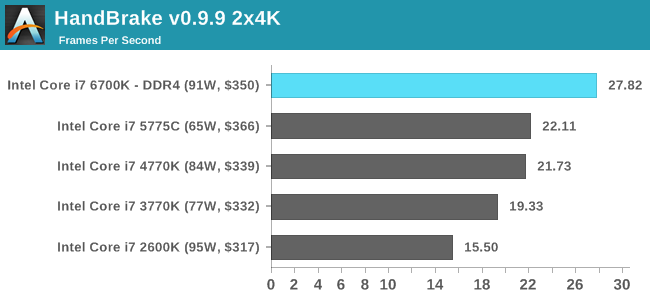
Hybrid x265
Hybrid is a new benchmark, where we take a 4K 1500 frame video and convert it into an x265 format without audio. Results are given in frames per second.











477 Comments
View All Comments
boeush - Friday, August 7, 2015 - link
A good point, but I think you missed this page in the review:http://www.anandtech.com/show/9483/intel-skylake-r...
The other pages where all CPUs are normalized to 3 Ghz are for generational IPC comparison, not memory scaling. The later "what you can buy" pages repeat all the same tests but with all CPUs at full default clocks, as well - to gauge the combined effect of IPC and frequency scaling across generations.
Still missing and hopefully to be addressed in a future follow-up, is a study of generational overclocked performance, and performance under DDR4 frequency scaling with and without CPU (other than memory) overclocking.
MrSpadge - Friday, August 7, 2015 - link
Well, on the page before the one you linked Ian says:"For these tests, both sets of numbers were run at 3.0 GHz with hyperthreading disabled. Memory speeds were DDR4-2133 C15 and DDR3-1866 C9 respectively."
I think this applies to both memory scaling pages.
You've got a good point, though, that the "what you can buy" section compares DDR4-2133 and DDR3-1600 (latency unspecified) at default CPU clocks. And from a quick glance the differences there are not that different from the ones obtained in the dedicated memory scaling section.
Nutti - Friday, August 7, 2015 - link
Left out all the AMD FX processors? Looks pretty bad for AMD this way. FX is still much better than 7870K. Zen will nicely catch up with Intel. AMD needs 40% improvement over FX8350 and they will sure get that through better IPC and multithreading.Bambooz - Friday, August 7, 2015 - link
Wishful thinking from a fanboiOxford Guy - Friday, August 7, 2015 - link
Ad hominem isn't a rebuttal, bud.Oxford Guy - Friday, August 7, 2015 - link
The FX does nicely in a modern game like Witcher 3 that uses all of its threads as can be seen here: http://www.techspot.com/review/1006-the-witcher-3-...Anandtech has been doing the "let's throw in a dozen APUs and completely ignore FX" for some time now. The only thing it accomplishes is obscuring the fact that the FX can be a better value for a workstation (rendering and such) that also has some gaming requirements.
nils_ - Friday, August 7, 2015 - link
You probably should have run the Linux Tests through Phoronix Test Suite, the Linux Bench seems rather outdated with Ubuntu 11.04 (we are on 15.04 now).eeessttaa - Friday, August 7, 2015 - link
Great article as always. I wish intel would leave the fivr in it. i know how hot it got but instead of removing it they should've improved on its design.Nelviego - Friday, August 7, 2015 - link
Seems it might finally be time to OC my i7 2600k and give it another 4 1/2 years. ;)Oxford Guy - Friday, August 7, 2015 - link
Intel made everyone think Skylake was going to be a massive improvement on all fronts. Massive IPC increase. Massive technological advance. People shilled for Intel by claiming it was highly likely that Skylake wouldn't need a new socket and would just use LGA 2011-3.Instead, we get ... what? Chips that aren't significantly better than Haswells, let alone Broadwell?
I guess Intel is sandbagging even more than usual since AMD isn't doing anything new on the CPU front. So much for all of the intense Skylake hype. It amazes me, too, how people are blithely now saying "I guess I'll wait for Kaby Lake" -- the same people, often enough, who said Skylake would revolutionize computing.
It looks like this is what happens when Intel has minimal competition. The FX chips are still clinging to relevance now that consoles have 8 threads and weak individual cores (not that you'd know it based on the way this site never puts even one of them into its reviews in favor of weaker APUs) -- and because rendering programs like Blender can use their threads which can make them a decent value for budget workstation use, but their design is from 2012 or so. Overclocking is also keeping old chips like the 2500K viable for gaming.
I admit I feel for the hype a bit. I was expecting at least some sort of paradigm-shifting new tech. Instead... I don't see anything impressive at all. A new socket... a small gain in efficiency... rinse repeat.
An article I read recently said that overclocking will become increasingly non-viable as process nodes shrink. It seems we're seeing that already. The article says an Intel executive said Intel is taking overclocking seriously but the company may not have much choice.
Intel should have included hardware devoted to h.265 encoding for Skylake at least. Maybe it did, but it's not like I can tell by the charts provided. What is the point of putting in that h.265 encoding chart and not including the fastest non-E Haswell (4790K) and a Haswell-E (5820K)? It makes it look like your site is trying to hype Skylake. Don't you think people who are doing a lot of tasks like that which require serious performance (like the "slowest" setting in Handbrake) are going to need to see a comparison with the best available options?